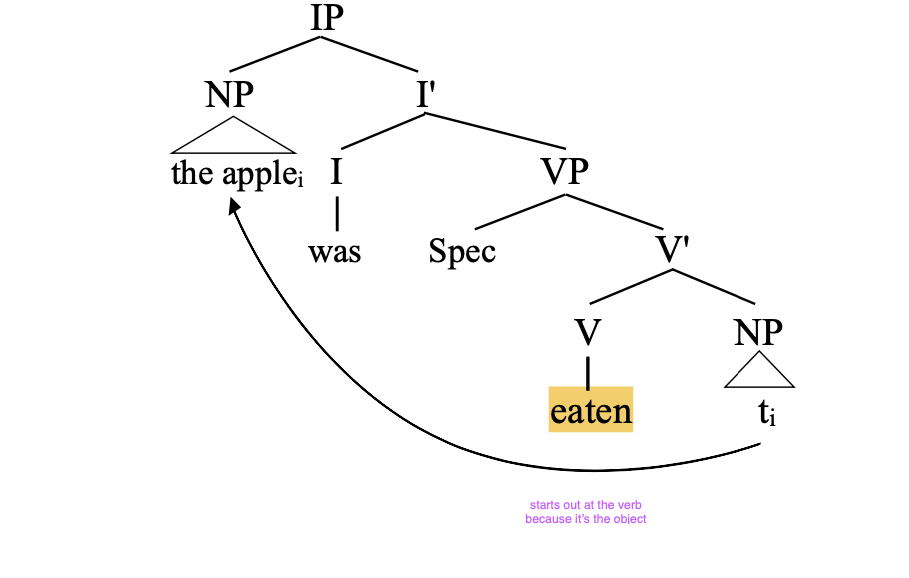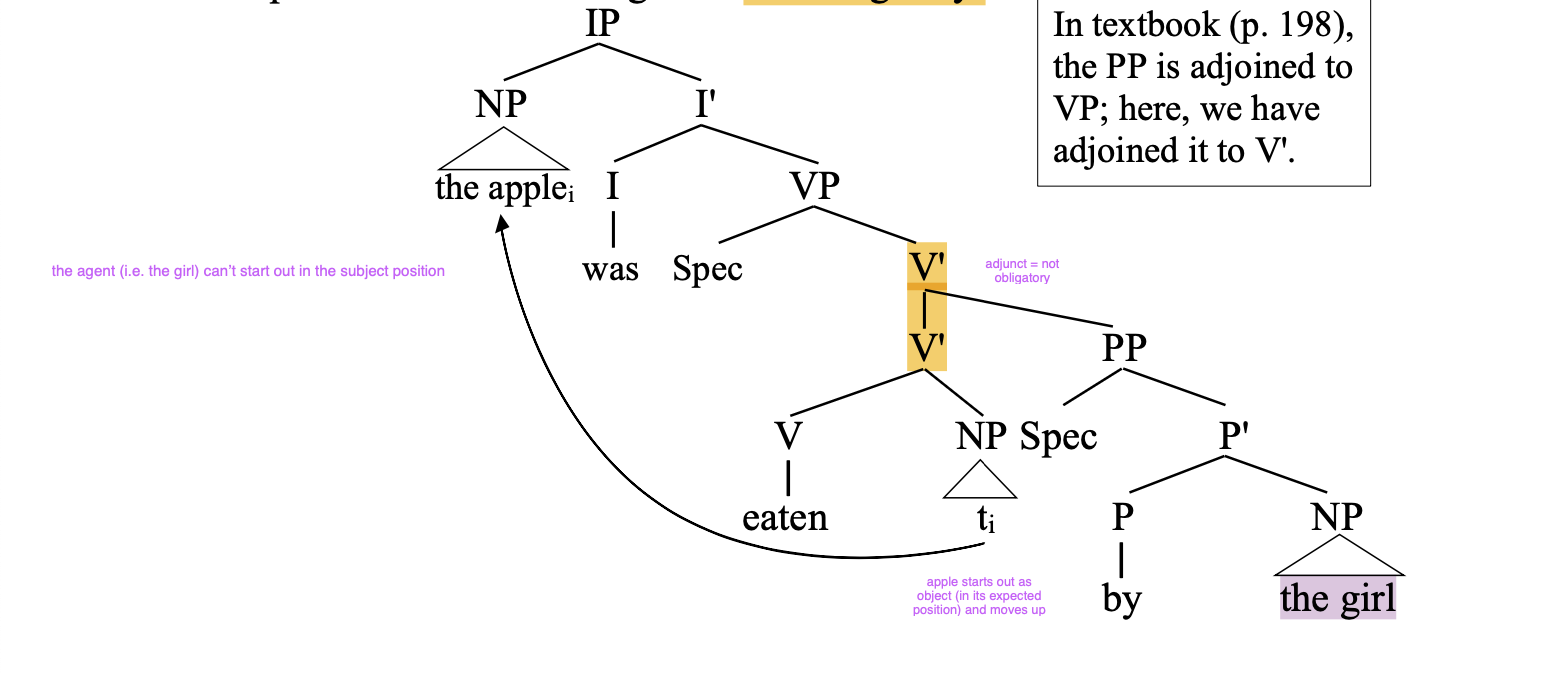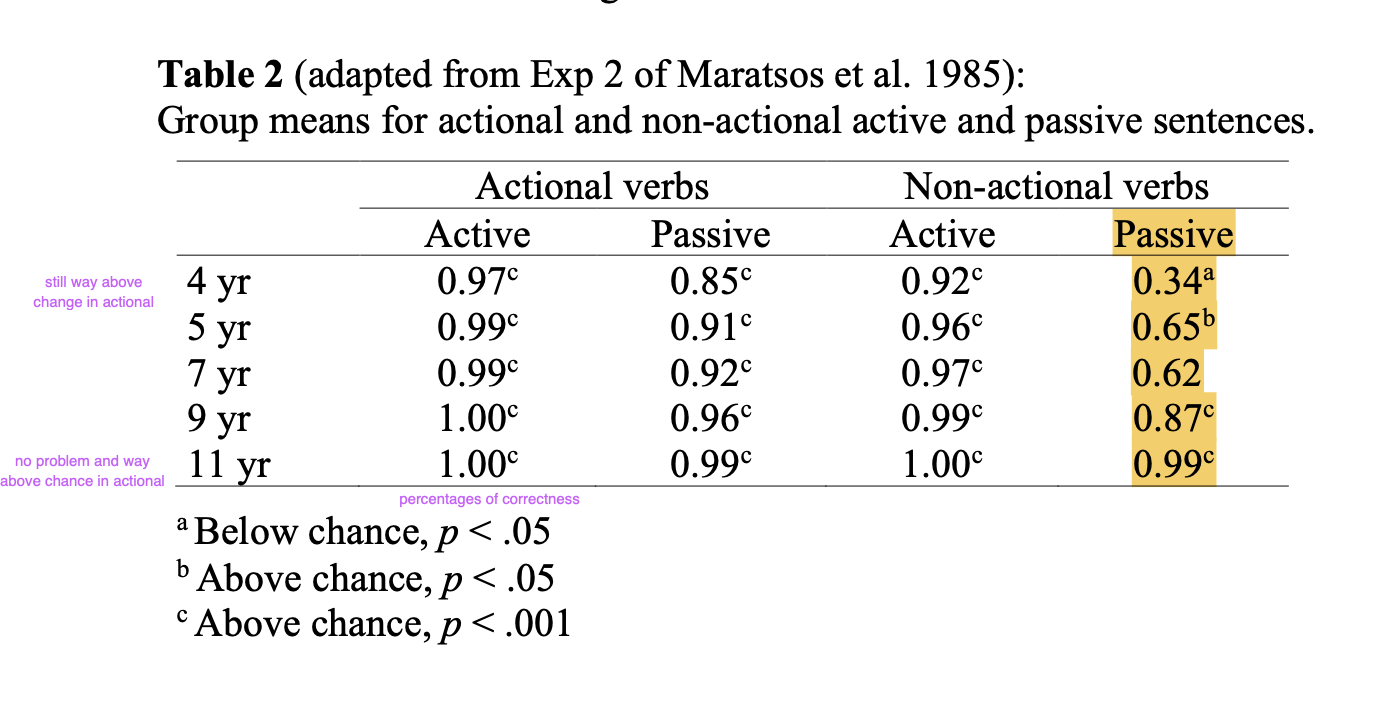14: acquisition of passives
1/22
There's no tags or description
Looks like no tags are added yet.
Name | Mastery | Learn | Test | Matching | Spaced |
|---|
No study sessions yet.
23 Terms
why do children acquire passives late
not sure if due to difficulties with movement or other properties of passives like:
input
order of NPs
presence/ absence of by-phrase
type of passive (agent and patient semantically reversible or not; verb is actional or non-actional)
thematic roles in passives
subject of passive is the theme/patient rather than the agent
the agent is optionally expressed in a prepositional phrase (PP)(‘by-phrase’): ex. the apple was eaten (by the girl)
short passive
no by-phrase; the agent is not expressed
ex. the apple was eaten
ex. Jamie was kicked
what is a long-passive
optional by-phrase is expressed;
ex. the apple was eaten by the girl
ex. Jamie was kicked by Robin

where are short phrases derived from
theme originates in object position
theme moves to subject position
deriving long passives
agent is base-generated in a PP inside the VP
the PP is an adjunct not an argument (it gets ‘demoted’ (lowered rank position))
adjunction provide additional info that is not needed to complete the meaning of a predicate
agent cannot be base generated in a grammatical subject position since the agent is not obligatory

what are the acquisition of passives impacted by (challenges):
order of NPs : non-canonical (agent =/= subject; theme =/= object)
input: passive are rare in child-directed speech in many languages (including English)
by-phrase: presence vs absence of by-phrase
type of passive: reversible vs non-reversible; actional vs non-actional
evidence in input
English
only 0.4% of verbal utterances in CDS are passive constructions
English children fail to comprehend some types of passives until 9 years of age
Sesotho
2.7% of verbal utterances in CDS are passive constructions;
Sesotho children comprehend all types of passives by 3;1.
Sesotho passives are more frequent in the input and they are used in more discourse contexts than English passives.
reversibility vs animacy in passives
subjects are typically animate and agents of actions (volitionally causing an event or change of state
subject and object are semantically reversible when both are animate :
ex. Jamie was kicked by Robin
Robin was kicked by Jamie
challenge: who is doing the kicking
subject and object are not (typically) reversible when only one is animate:
ex. the apple was eaten by the girl
less challenging: the girl is animate; apple is inanimate
actional vs non-actional verbs
actional verbs denote actions or events that are observable; the theme/patient is affected by the event:
ex. the apple was eaten
ex. jamie was kicked
Non-actional verbs denote a state or something less visible; includes verbs of perception or emotion:
ex. the boy was seen
ex. Sarah was remembered
de Villiers & de Villiers act-out study (1973)
33 children, aged 19-38 months;
Calculated MLU for each child (it proved to be a better predictor for behaviour than age);
Act out task: Child provided with toys and/or props; experimenter asks the child to act out a sentence;
Stimuli involved reversible passive and active sentences, all with actional verbs:
ex. the horse was pushed by the donkey
the horse pushed the donkey
results from de Villiers & de Villiers study (1973) at MLU 1.5
Low accuracy with reversible passive and reversible active sentences
Errors:
Children place themselves as the agent:
The horse was pushed by the donkey. (act out: child pushes donkey)Children reverse the arguments:
The horse was pushed by the donkey. (act out: child has horse push donkey)
results from de Villiers & de Villiers study (1973) at MLU 1.5-3
Children act out reversible active sentences well: 80+% accuracy;
Still do poorly with reversible passives: ~30% accuracy.
results from de Villiers & de Villiers study (1973) at MLU 3.5-4.25
Some improvement with reversible passives but still quite low: ~40% accuracy.
The oldest children in this study are 3;2 – children perform a lot better by age 4
what do findings on non-actionable verbs show
English-learning children have problems with non-actional passive constructions until about the age of 9
Performance on non-actional verbs gets better when stimuli do not contain a by-phrase
maratos et al. (1985) study
80 children, aged 4-11;
Picture identification task to test comprehension of passives with actional verbs (wash, kiss, push, kick) and non-actional verbs (see, hear, love, fear); active sentences also included;
The child is shown two pictures for each verb. The experimenter says a sentence and the child has to point to the correct picture
ex. sentence with actional verb: Mickey is held by Batman.
with non-actional verb: Mickey is seen by Batman.
results— meratsos study
Accuracy on actional passives is high even for youngest group (4-year-olds);
Accuracy on non-actional passives is low; above-chance performance is not observed until age 9!

Fox and Godzinsky (1998) study: Do children’s performance in non-actional passive improve without the by-phrase?
Goal is to test whether children’s performance on non-actional passives improves without the by-phrase.
In such sentences, there is no competition between the two NPs, both of which could be agents.
13 children, aged 3;6 to 5;5.
Truth value judgement task: Child listens to short story accompanied by pictures. Puppet who is “learning language” summarizes story at end – correctly or incorrectly. Child says whether puppet was correct or incorrect
results of Fox & Grodzinsky (1998) study
more accurate responses with short passives than with long passives (by-phrases)
ex. The boy is seen. (≈85% accuracy)
The boy is seen by the horse. (≈45% accuracy)
Interpretation: Children’s difficulty with passives involves understanding how the agent is expressed in a by-phrase, not the movement of the object.
spontaneous production
Evidence for PRODUCTIVITY of passives (knowing how they work) in spontaneous production: children create novel passives, suggesting that their grammars do permit passive constructions
It was bandaided. (age 3;4)
Is it all needled. (age 3;2)
I don’t like being fallen down on. (age 4)When producing passives, children correctly move the object: “the puppy got washed” → *got washed the puppy
however, long passives are rarely produced spontaneously (i.e. without being prompted)
elicited production task
4-year old children were taught novel verbs (through demonstration of actions).
Training phase:
• Verbs were presented to children in either active or passive voice;
Example: they would learn that gomp means ' to back into’.
Testing phase:
• To elicit production of passive, children heard a story that provided a context for the use of passive with the novel verb.
• The child is expected to say either:
The elephant is being gomped (by the tiger), or
The tiger is gomping the elephant
Passive (a) is expected because the tiger hasn’t been mentioned yet
effective production task results
Children used more actives than passives in their responses;
This is not surprising because passives were not required in such cases;
Adults also tend to prefer actives in similar tasks.
However:
Passives were sometimes produced by the children;
This happened regardless of whether or not the child had been trained on the active or passive forms of the verb;
This suggests productive knowledge of passive constructions;
In a subsequent task, children were tested via act-out task on comprehension of the novel verbs (e.g., ‘can you make it so that the elephant is gomped by the tiger’) and showed above-chance comprehension of passives.
are passives ever acquired early on in production
Early production of passives is more common in languages where passives are required in many discourse contexts;
Example: In Sesotho, the questioning of subjects requires passives:
Di-jo di-pheh-w-a ke mang? 8-food 8agr-cook-PASS-FV by 1-who ‘The food is being cooked by who?’
• Findings:
2-year-old children produce passives regularly and correctly (Demuth 1989).